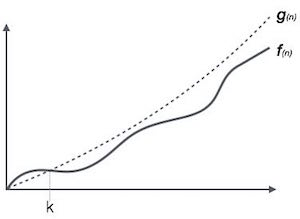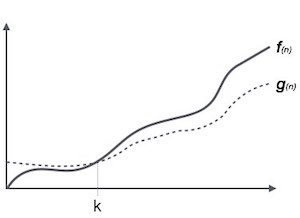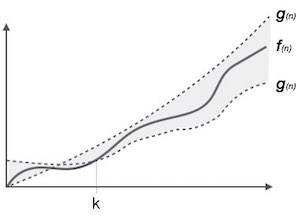Asymptotic analysis in Data Structures and Algorithms
In the previous chapter, we learned about theoretical analysis and some concepts of time complexity and memory complexity in algorithm analysis. In this chapter, I will discuss Proximity Analysis in Data Structures and Algorithms.
What is proximity analysis?
The asymptotic analysis of an algorithm is a concept that helps us estimate the running time of an algorithm. Using asymptotic analysis, we can draw the best conclusions about the best case scenario, the average case, the worst case of an algorithm. To refer to these cases, you can learn what is the Data Structures chapter?
Asymptotic analysis means approaching input data, ie if the algorithm does not have Input, the final conclusion is that the algorithm will run for a specific amount of time and is constant. In addition to the Input factor, other factors are considered constant.
Asymptotic analysis refers to estimating the running time of any calculation in the calculation steps. For example, the running time of a certain calculation is evaluated as a function f (n) and for another calculation is the function g (n2). This means that the running time of the first calculation will increase linearly with the increase of n and the running time of the second calculation will increase exponentially when n increases. Similarly, when n is quite small, the running time of the two operations is nearly the same.
Usually the time required by an algorithm is divided into 3 categories:
- Best case : is the smallest time required to execute the program.
- Average case : is the average time needed to implement the program.
- Worst case : is the maximum time required to execute the program.
Asymptotic Notation in Data Structures and Algorithms
The following Asymptotic Notation is commonly used in estimating the run-time complexity of an algorithm:
Ation Notation
Ation Notation
ation Notation
Big Oh Notation, Ο in Data Structures and Algorithms
Ο (n) is a way to represent the upper bound of the runtime of an algorithm. It estimates the worst-case time complexity or is the longest amount of time required by an algorithm (executed from start to end). The graph shows as follows:

For example, calling f (n) and g (n) are functions that do not reduce the definition on positive integers (all time functions satisfy these conditions):
Ο( f ( n )) = { g ( n ) : n ế u t ồ n t ạ i c > 0 v à n 0 sao cho g ( n ) ≤ c . f ( n ) v ớ i m ọ i n > n 0 . } Omega Notation, Ω in Data structures and algorithms
The Ω (n) is a way to represent the lower bound of an algorithm's runtime. It estimates the best case-time complexity or is the shortest amount of time required by an algorithm. The graph shows as follows:

For example, with a function f (n):
Ω( f ( n )) ≥ { g ( n ) : n ế u t ồ n t ạ i c > 0 v à n 0 sao cho g ( n ) ≤ c . f ( n ) v ớ i m ọ i n > n 0 . } Theta Notation, θ in Data structures and algorithms
The θ (n) is a way to represent both the upper and lower bound of the run time of an algorithm. You look at the item:

Some Asymptotic Notation is popular in data structures and algorithms
constant - Ο (1)
logarithm - Ο (log n)
Linear (Linear) - Ο (n)
n log n - Ο (n log n)
Quadratic - Ο (n 2 )
Tier 3 (cubic) - Ο (n 3 )
Polynomial - n Ο (1)
Exponential - 2 Ο (n)
According to Tutorialspoint
Last lesson: What is algorithm?
Next lesson: Greedy Algorithm (Greedy Algorithm)
You should read it
- Algorithms arranged in data structures & algorithms
- How to Create Superscript and Subscript in MS Word
- How to Open KML Files
- What is data analysis?
- What is algorithm?
- What do the strange icons on the back of the iPhone mean?
- Drink Omega 3 properly how to be effective
- What is Omega 3? Is it good to drink lots of Omega 3?
May be interested
- How to Run Regression Analysis in Microsoft Excel
 regression analysis can be very helpful for analyzing large amounts of data and making forecasts and predictions. to run regression analysis in microsoft excel, follow these instructions. if your version of excel displays the ribbon (home,...
regression analysis can be very helpful for analyzing large amounts of data and making forecasts and predictions. to run regression analysis in microsoft excel, follow these instructions. if your version of excel displays the ribbon (home,... - How to use Quick Analysis in Excel
 want to quickly and easily analyze data in a spreadsheet? let's learn how to use quick analysis in excel.
want to quickly and easily analyze data in a spreadsheet? let's learn how to use quick analysis in excel. - How to Solve Random Beads, Overlapping Spiral, Asymptotic Axes Problems
 in this article, you'll learn how to solve the old problems of random beads in a ring, the overlapping spiral and the asymptotic axes problems by following the steps below to make images like this one. become familiar with some of the...
in this article, you'll learn how to solve the old problems of random beads in a ring, the overlapping spiral and the asymptotic axes problems by following the steps below to make images like this one. become familiar with some of the... - Deep search algorithm
 deep search algorithms (depth first search - dfs for short), also called depth-first search algorithms, are algorithms that browse or search on a tree or graph and use the stack ( stack) to remember adjacent vertices to start the search when the adjacent vertex is not encountered in any loop.
deep search algorithms (depth first search - dfs for short), also called depth-first search algorithms, are algorithms that browse or search on a tree or graph and use the stack ( stack) to remember adjacent vertices to start the search when the adjacent vertex is not encountered in any loop. - Browse trees in data structures and algorithms
 tree browsing is a process for accessing all the nodes of a tree and can also print the values of these nodes. because all nodes are connected via edges (or links), we always start accessing from the root node.
tree browsing is a process for accessing all the nodes of a tree and can also print the values of these nodes. because all nodes are connected via edges (or links), we always start accessing from the root node. - How to implement a graph data structure in Golang
 charts are one of the essential data structures that you must know as a programmer. let's learn how to create graph/graph data structures in golang !
charts are one of the essential data structures that you must know as a programmer. let's learn how to create graph/graph data structures in golang ! - 4 Advanced PivotTable Functions for Excel Data Analysis
 data analysis is not easy. so, to enhance your data, you can use a range of advanced pivottable functions in excel.
data analysis is not easy. so, to enhance your data, you can use a range of advanced pivottable functions in excel. - Fibonacci series in Data Structures and Algorithms
 the fibonacci sequence creates numbers by adding two numbers in front. fibonacci series start from two numbers: f0 & f1. the initial value of f0 & f1 may be 0, 1 or 1, 1, respectively.
the fibonacci sequence creates numbers by adding two numbers in front. fibonacci series start from two numbers: f0 & f1. the initial value of f0 & f1 may be 0, 1 or 1, 1, respectively. - Greedy Algorithm (Greedy Algorithm)
 greedy algorithm is a combination optimization algorithm. search algorithms, select local optimal solutions in each step in the hope of finding a global optimal solution.
greedy algorithm is a combination optimization algorithm. search algorithms, select local optimal solutions in each step in the hope of finding a global optimal solution. - Alignment algorithm (Merge Sort)
 mixing (merge sort) is an arrangement algorithm based on the divide and conquer algorithm. with the worst case time complexity of Ο (n log n), this is one of the algorithms that deserves the most attention.
mixing (merge sort) is an arrangement algorithm based on the divide and conquer algorithm. with the worst case time complexity of Ο (n log n), this is one of the algorithms that deserves the most attention.










 Dynamic Programming (Dynamic Programming)
Dynamic Programming (Dynamic Programming) Master Theorem algorithm (Master Theorem)
Master Theorem algorithm (Master Theorem) Linked list data structure (Linked List)
Linked list data structure (Linked List) Data structure of double linked list
Data structure of double linked list Data Link List structure (Circular Linked List)
Data Link List structure (Circular Linked List)